SOSTAC Model Analysis: Sainsbury's Marketing Strategy in Italy and UK
VerifiedAdded on 2023/01/05
|20
|4050
|1
Report
AI Summary
This report analyzes Sainsbury's marketing strategy using the SOSTAC model, focusing on its application in both Italy and the UK. The report begins with an executive summary and table of contents, followed by an introduction to the SOSTAC model (Situation analysis, Objectives, Strategy, Tactics, Actions, and Control). The discussion section is divided into two tasks. Task 1 focuses on developing a SOSTAC model for Sainsbury's operations in Italy, including a PEST analysis of the Italian macro-environment, SMART objectives, strategy (Porter's generic forces and Ansoff Matrix), tactics, action plans, and control measures. Task 2 applies the SOSTAC model to Sainsbury's UK operations, covering situation analysis, objectives, strategy, tactics (product segmentation, pricing, and place), action, and control. The report incorporates diagrams, tables, and figures to illustrate key concepts. The report concludes with recommendations for Sainsbury's strategic direction and includes a comprehensive list of references.
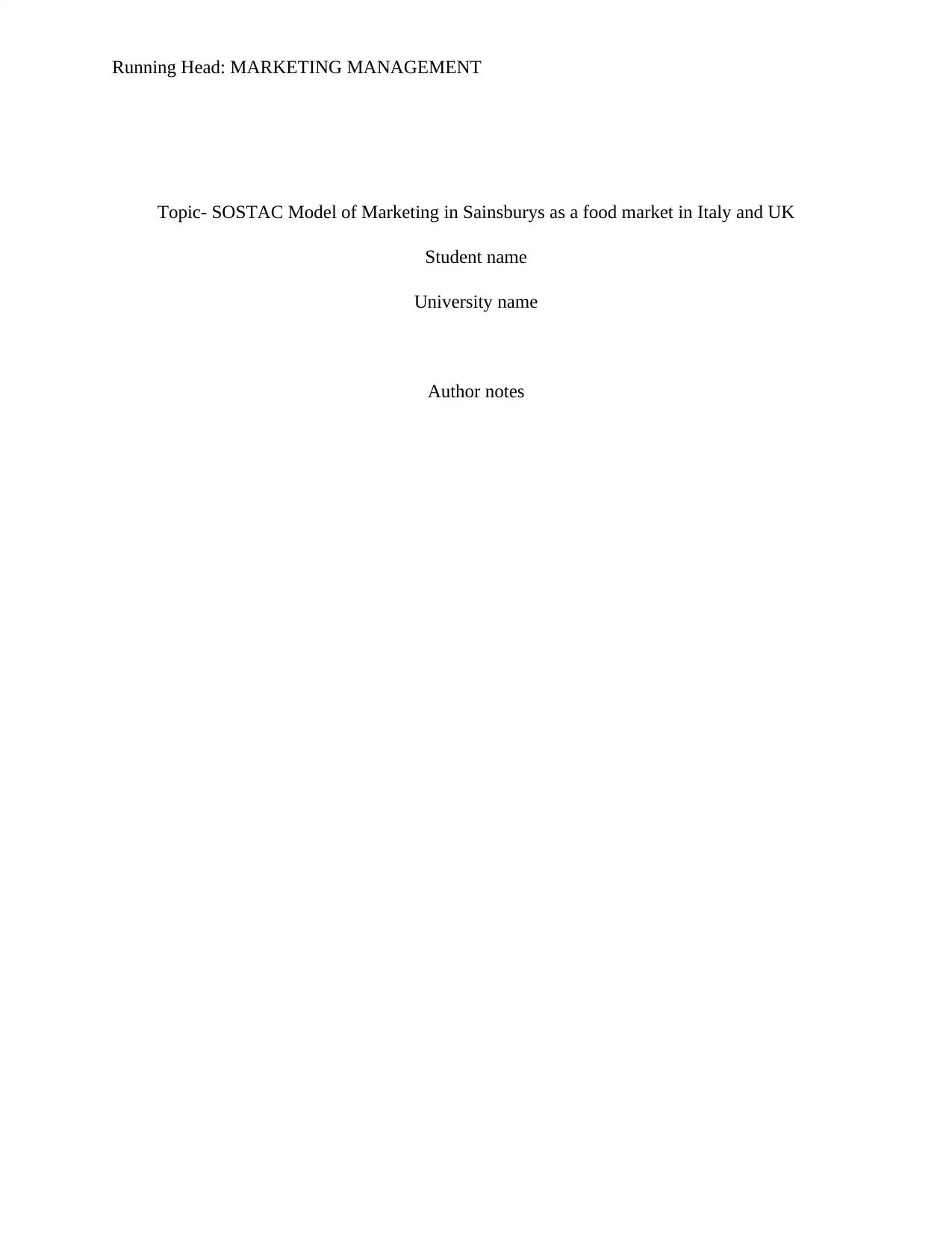
Running Head: MARKETING MANAGEMENT
Topic- SOSTAC Model of Marketing in Sainsburys as a food market in Italy and UK
Student name
University name
Author notes
Topic- SOSTAC Model of Marketing in Sainsburys as a food market in Italy and UK
Student name
University name
Author notes
Paraphrase This Document
Need a fresh take? Get an instant paraphrase of this document with our AI Paraphraser
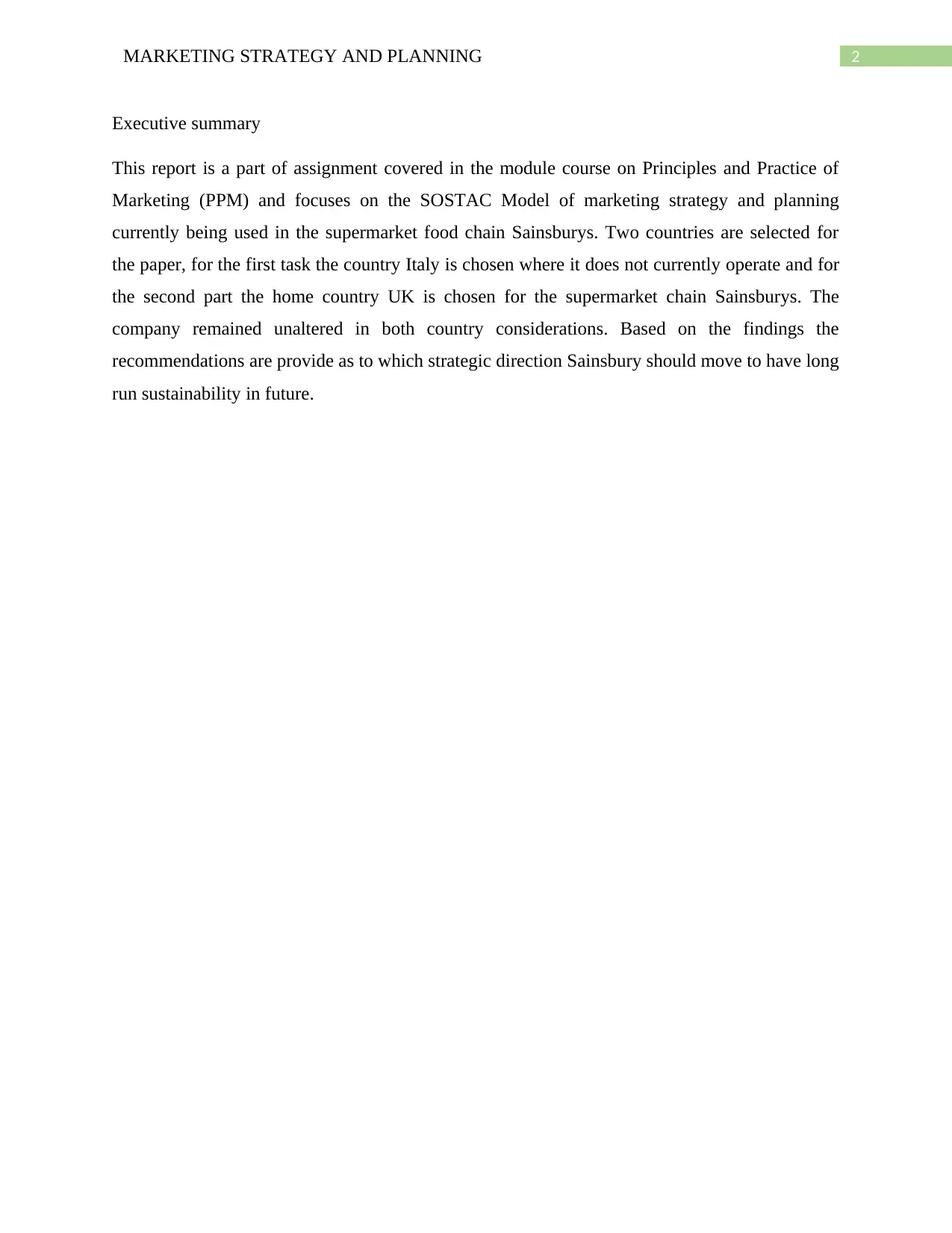
2MARKETING STRATEGY AND PLANNING
Executive summary
This report is a part of assignment covered in the module course on Principles and Practice of
Marketing (PPM) and focuses on the SOSTAC Model of marketing strategy and planning
currently being used in the supermarket food chain Sainsburys. Two countries are selected for
the paper, for the first task the country Italy is chosen where it does not currently operate and for
the second part the home country UK is chosen for the supermarket chain Sainsburys. The
company remained unaltered in both country considerations. Based on the findings the
recommendations are provide as to which strategic direction Sainsbury should move to have long
run sustainability in future.
Executive summary
This report is a part of assignment covered in the module course on Principles and Practice of
Marketing (PPM) and focuses on the SOSTAC Model of marketing strategy and planning
currently being used in the supermarket food chain Sainsburys. Two countries are selected for
the paper, for the first task the country Italy is chosen where it does not currently operate and for
the second part the home country UK is chosen for the supermarket chain Sainsburys. The
company remained unaltered in both country considerations. Based on the findings the
recommendations are provide as to which strategic direction Sainsbury should move to have long
run sustainability in future.
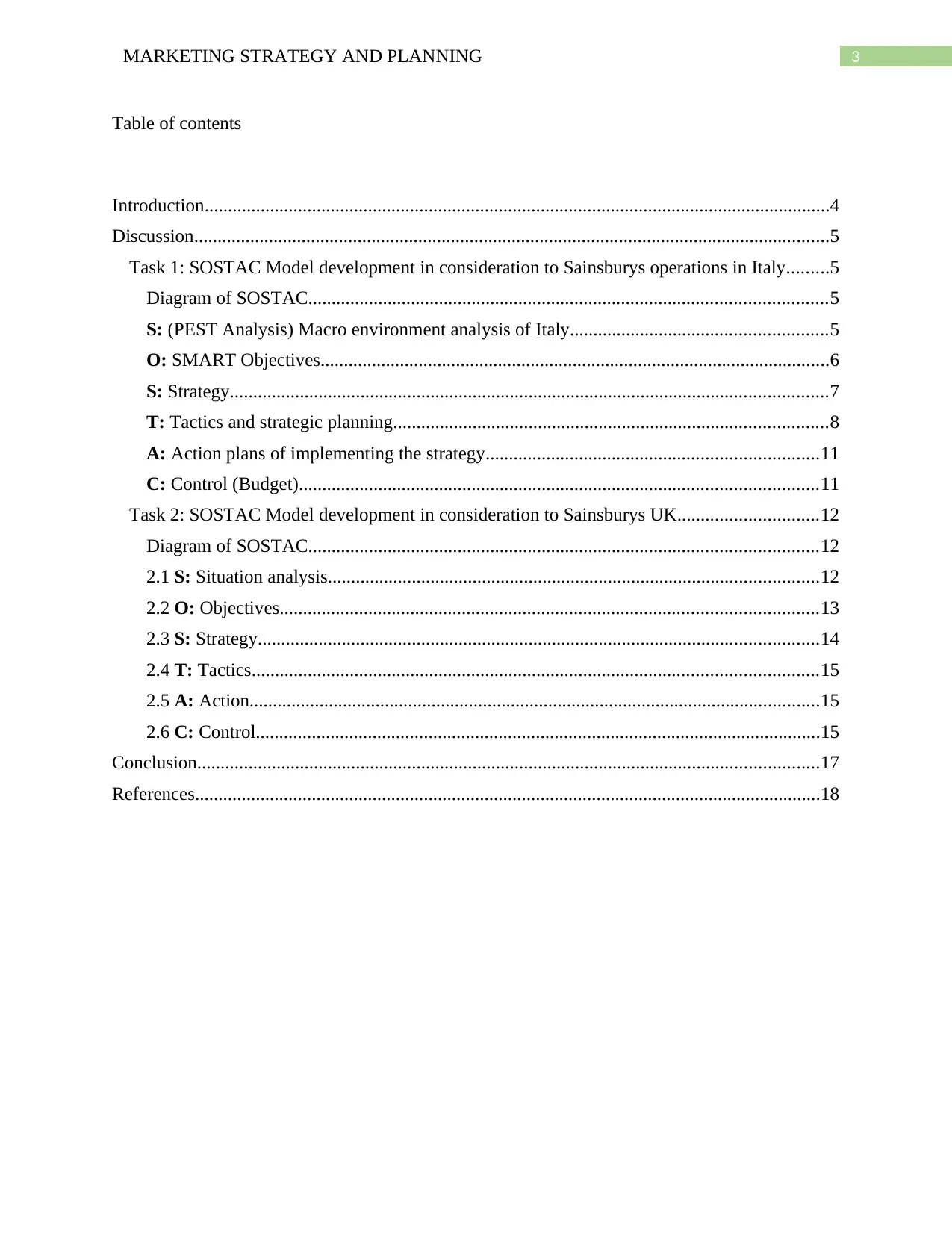
3MARKETING STRATEGY AND PLANNING
Table of contents
Introduction......................................................................................................................................4
Discussion........................................................................................................................................5
Task 1: SOSTAC Model development in consideration to Sainsburys operations in Italy.........5
Diagram of SOSTAC...............................................................................................................5
S: (PEST Analysis) Macro environment analysis of Italy.......................................................5
O: SMART Objectives.............................................................................................................6
S: Strategy................................................................................................................................7
T: Tactics and strategic planning.............................................................................................8
A: Action plans of implementing the strategy.......................................................................11
C: Control (Budget)...............................................................................................................11
Task 2: SOSTAC Model development in consideration to Sainsburys UK..............................12
Diagram of SOSTAC.............................................................................................................12
2.1 S: Situation analysis.........................................................................................................12
2.2 O: Objectives...................................................................................................................13
2.3 S: Strategy........................................................................................................................14
2.4 T: Tactics.........................................................................................................................15
2.5 A: Action..........................................................................................................................15
2.6 C: Control.........................................................................................................................15
Conclusion.....................................................................................................................................17
References......................................................................................................................................18
Table of contents
Introduction......................................................................................................................................4
Discussion........................................................................................................................................5
Task 1: SOSTAC Model development in consideration to Sainsburys operations in Italy.........5
Diagram of SOSTAC...............................................................................................................5
S: (PEST Analysis) Macro environment analysis of Italy.......................................................5
O: SMART Objectives.............................................................................................................6
S: Strategy................................................................................................................................7
T: Tactics and strategic planning.............................................................................................8
A: Action plans of implementing the strategy.......................................................................11
C: Control (Budget)...............................................................................................................11
Task 2: SOSTAC Model development in consideration to Sainsburys UK..............................12
Diagram of SOSTAC.............................................................................................................12
2.1 S: Situation analysis.........................................................................................................12
2.2 O: Objectives...................................................................................................................13
2.3 S: Strategy........................................................................................................................14
2.4 T: Tactics.........................................................................................................................15
2.5 A: Action..........................................................................................................................15
2.6 C: Control.........................................................................................................................15
Conclusion.....................................................................................................................................17
References......................................................................................................................................18
⊘ This is a preview!⊘
Do you want full access?
Subscribe today to unlock all pages.

Trusted by 1+ million students worldwide
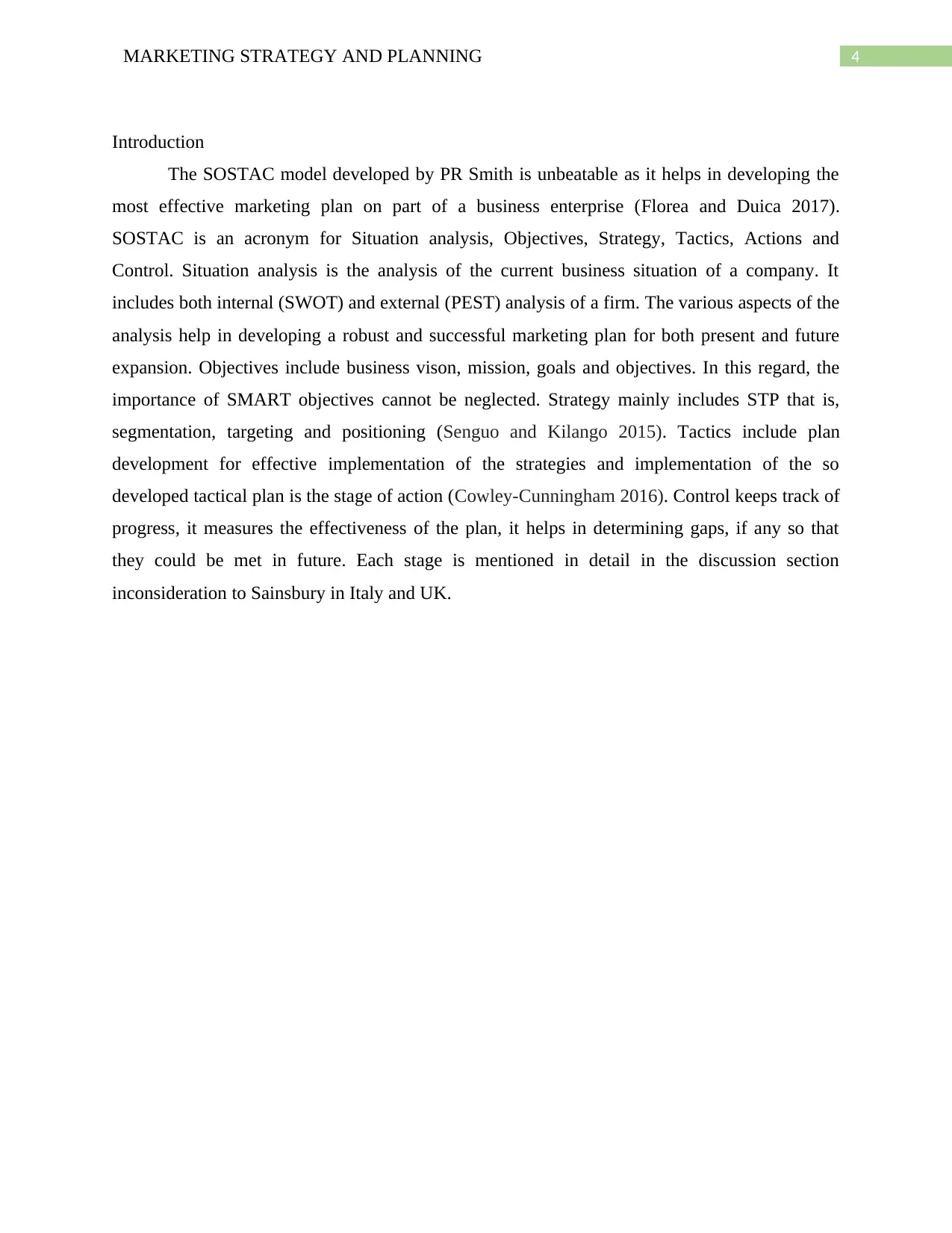
4MARKETING STRATEGY AND PLANNING
Introduction
The SOSTAC model developed by PR Smith is unbeatable as it helps in developing the
most effective marketing plan on part of a business enterprise (Florea and Duica 2017).
SOSTAC is an acronym for Situation analysis, Objectives, Strategy, Tactics, Actions and
Control. Situation analysis is the analysis of the current business situation of a company. It
includes both internal (SWOT) and external (PEST) analysis of a firm. The various aspects of the
analysis help in developing a robust and successful marketing plan for both present and future
expansion. Objectives include business vison, mission, goals and objectives. In this regard, the
importance of SMART objectives cannot be neglected. Strategy mainly includes STP that is,
segmentation, targeting and positioning (Senguo and Kilango 2015). Tactics include plan
development for effective implementation of the strategies and implementation of the so
developed tactical plan is the stage of action (Cowley-Cunningham 2016). Control keeps track of
progress, it measures the effectiveness of the plan, it helps in determining gaps, if any so that
they could be met in future. Each stage is mentioned in detail in the discussion section
inconsideration to Sainsbury in Italy and UK.
Introduction
The SOSTAC model developed by PR Smith is unbeatable as it helps in developing the
most effective marketing plan on part of a business enterprise (Florea and Duica 2017).
SOSTAC is an acronym for Situation analysis, Objectives, Strategy, Tactics, Actions and
Control. Situation analysis is the analysis of the current business situation of a company. It
includes both internal (SWOT) and external (PEST) analysis of a firm. The various aspects of the
analysis help in developing a robust and successful marketing plan for both present and future
expansion. Objectives include business vison, mission, goals and objectives. In this regard, the
importance of SMART objectives cannot be neglected. Strategy mainly includes STP that is,
segmentation, targeting and positioning (Senguo and Kilango 2015). Tactics include plan
development for effective implementation of the strategies and implementation of the so
developed tactical plan is the stage of action (Cowley-Cunningham 2016). Control keeps track of
progress, it measures the effectiveness of the plan, it helps in determining gaps, if any so that
they could be met in future. Each stage is mentioned in detail in the discussion section
inconsideration to Sainsbury in Italy and UK.
Paraphrase This Document
Need a fresh take? Get an instant paraphrase of this document with our AI Paraphraser
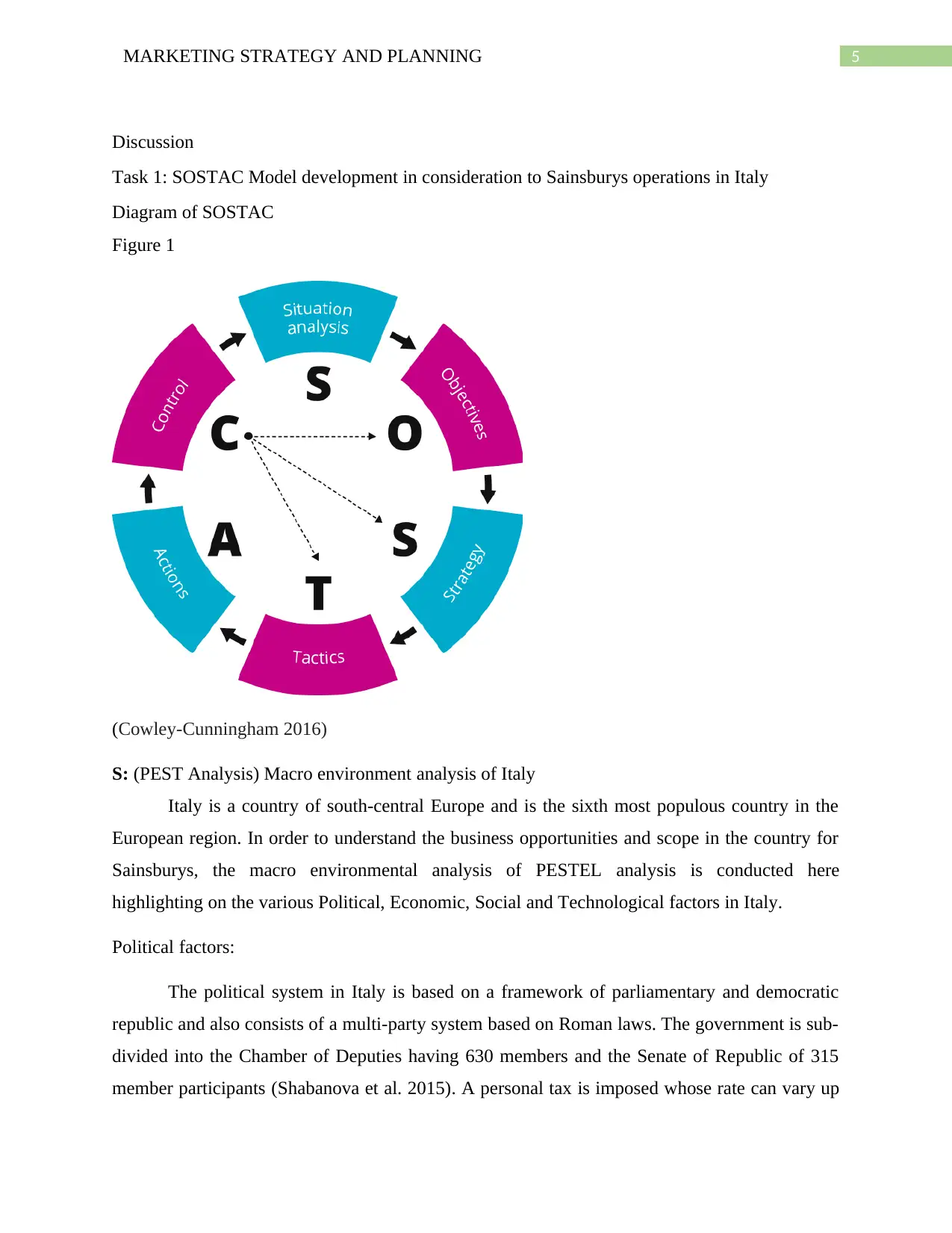
5MARKETING STRATEGY AND PLANNING
Discussion
Task 1: SOSTAC Model development in consideration to Sainsburys operations in Italy
Diagram of SOSTAC
Figure 1
(Cowley-Cunningham 2016)
S: (PEST Analysis) Macro environment analysis of Italy
Italy is a country of south-central Europe and is the sixth most populous country in the
European region. In order to understand the business opportunities and scope in the country for
Sainsburys, the macro environmental analysis of PESTEL analysis is conducted here
highlighting on the various Political, Economic, Social and Technological factors in Italy.
Political factors:
The political system in Italy is based on a framework of parliamentary and democratic
republic and also consists of a multi-party system based on Roman laws. The government is sub-
divided into the Chamber of Deputies having 630 members and the Senate of Republic of 315
member participants (Shabanova et al. 2015). A personal tax is imposed whose rate can vary up
Discussion
Task 1: SOSTAC Model development in consideration to Sainsburys operations in Italy
Diagram of SOSTAC
Figure 1
(Cowley-Cunningham 2016)
S: (PEST Analysis) Macro environment analysis of Italy
Italy is a country of south-central Europe and is the sixth most populous country in the
European region. In order to understand the business opportunities and scope in the country for
Sainsburys, the macro environmental analysis of PESTEL analysis is conducted here
highlighting on the various Political, Economic, Social and Technological factors in Italy.
Political factors:
The political system in Italy is based on a framework of parliamentary and democratic
republic and also consists of a multi-party system based on Roman laws. The government is sub-
divided into the Chamber of Deputies having 630 members and the Senate of Republic of 315
member participants (Shabanova et al. 2015). A personal tax is imposed whose rate can vary up
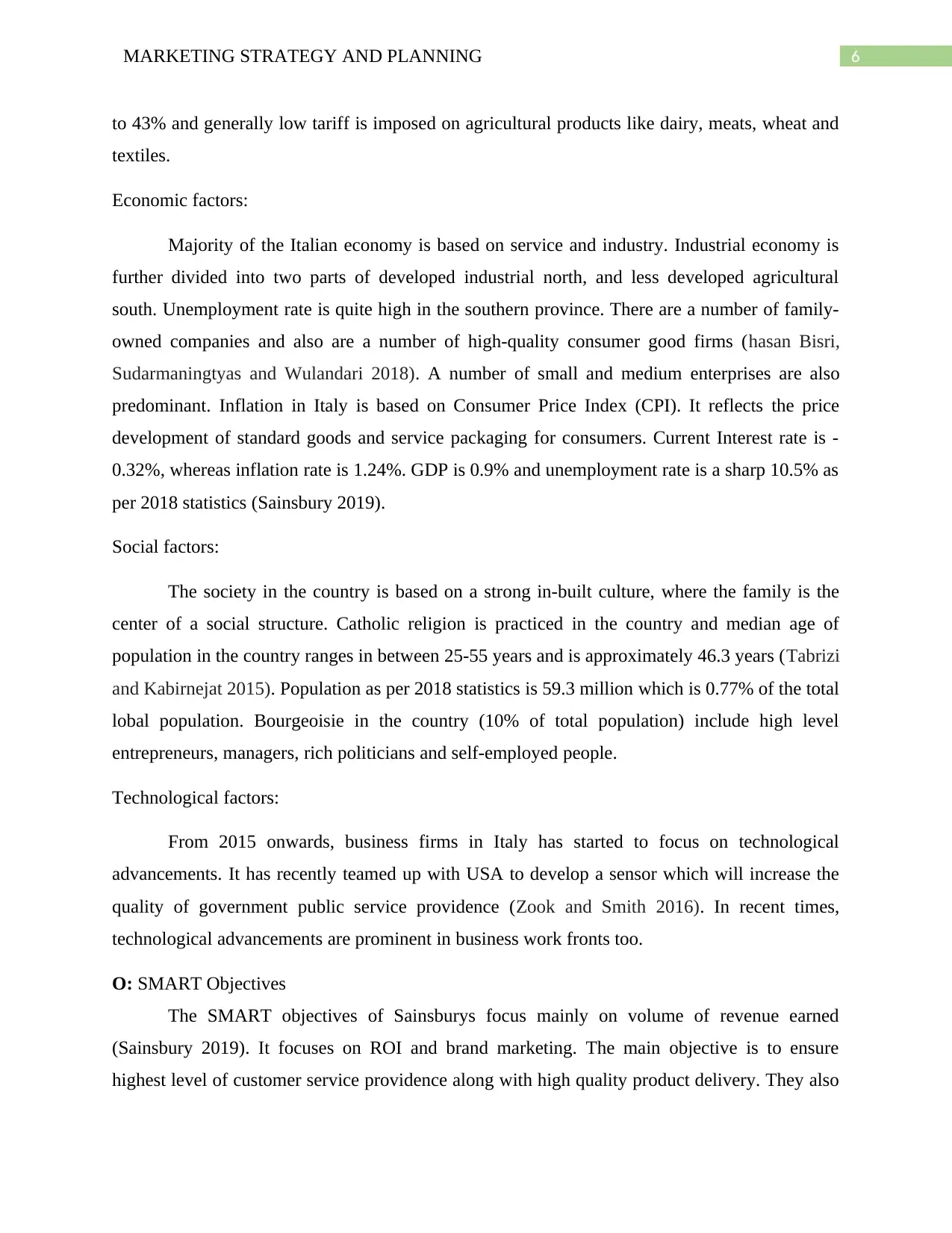
6MARKETING STRATEGY AND PLANNING
to 43% and generally low tariff is imposed on agricultural products like dairy, meats, wheat and
textiles.
Economic factors:
Majority of the Italian economy is based on service and industry. Industrial economy is
further divided into two parts of developed industrial north, and less developed agricultural
south. Unemployment rate is quite high in the southern province. There are a number of family-
owned companies and also are a number of high-quality consumer good firms (hasan Bisri,
Sudarmaningtyas and Wulandari 2018). A number of small and medium enterprises are also
predominant. Inflation in Italy is based on Consumer Price Index (CPI). It reflects the price
development of standard goods and service packaging for consumers. Current Interest rate is -
0.32%, whereas inflation rate is 1.24%. GDP is 0.9% and unemployment rate is a sharp 10.5% as
per 2018 statistics (Sainsbury 2019).
Social factors:
The society in the country is based on a strong in-built culture, where the family is the
center of a social structure. Catholic religion is practiced in the country and median age of
population in the country ranges in between 25-55 years and is approximately 46.3 years (Tabrizi
and Kabirnejat 2015). Population as per 2018 statistics is 59.3 million which is 0.77% of the total
lobal population. Bourgeoisie in the country (10% of total population) include high level
entrepreneurs, managers, rich politicians and self-employed people.
Technological factors:
From 2015 onwards, business firms in Italy has started to focus on technological
advancements. It has recently teamed up with USA to develop a sensor which will increase the
quality of government public service providence (Zook and Smith 2016). In recent times,
technological advancements are prominent in business work fronts too.
O: SMART Objectives
The SMART objectives of Sainsburys focus mainly on volume of revenue earned
(Sainsbury 2019). It focuses on ROI and brand marketing. The main objective is to ensure
highest level of customer service providence along with high quality product delivery. They also
to 43% and generally low tariff is imposed on agricultural products like dairy, meats, wheat and
textiles.
Economic factors:
Majority of the Italian economy is based on service and industry. Industrial economy is
further divided into two parts of developed industrial north, and less developed agricultural
south. Unemployment rate is quite high in the southern province. There are a number of family-
owned companies and also are a number of high-quality consumer good firms (hasan Bisri,
Sudarmaningtyas and Wulandari 2018). A number of small and medium enterprises are also
predominant. Inflation in Italy is based on Consumer Price Index (CPI). It reflects the price
development of standard goods and service packaging for consumers. Current Interest rate is -
0.32%, whereas inflation rate is 1.24%. GDP is 0.9% and unemployment rate is a sharp 10.5% as
per 2018 statistics (Sainsbury 2019).
Social factors:
The society in the country is based on a strong in-built culture, where the family is the
center of a social structure. Catholic religion is practiced in the country and median age of
population in the country ranges in between 25-55 years and is approximately 46.3 years (Tabrizi
and Kabirnejat 2015). Population as per 2018 statistics is 59.3 million which is 0.77% of the total
lobal population. Bourgeoisie in the country (10% of total population) include high level
entrepreneurs, managers, rich politicians and self-employed people.
Technological factors:
From 2015 onwards, business firms in Italy has started to focus on technological
advancements. It has recently teamed up with USA to develop a sensor which will increase the
quality of government public service providence (Zook and Smith 2016). In recent times,
technological advancements are prominent in business work fronts too.
O: SMART Objectives
The SMART objectives of Sainsburys focus mainly on volume of revenue earned
(Sainsbury 2019). It focuses on ROI and brand marketing. The main objective is to ensure
highest level of customer service providence along with high quality product delivery. They also
⊘ This is a preview!⊘
Do you want full access?
Subscribe today to unlock all pages.

Trusted by 1+ million students worldwide
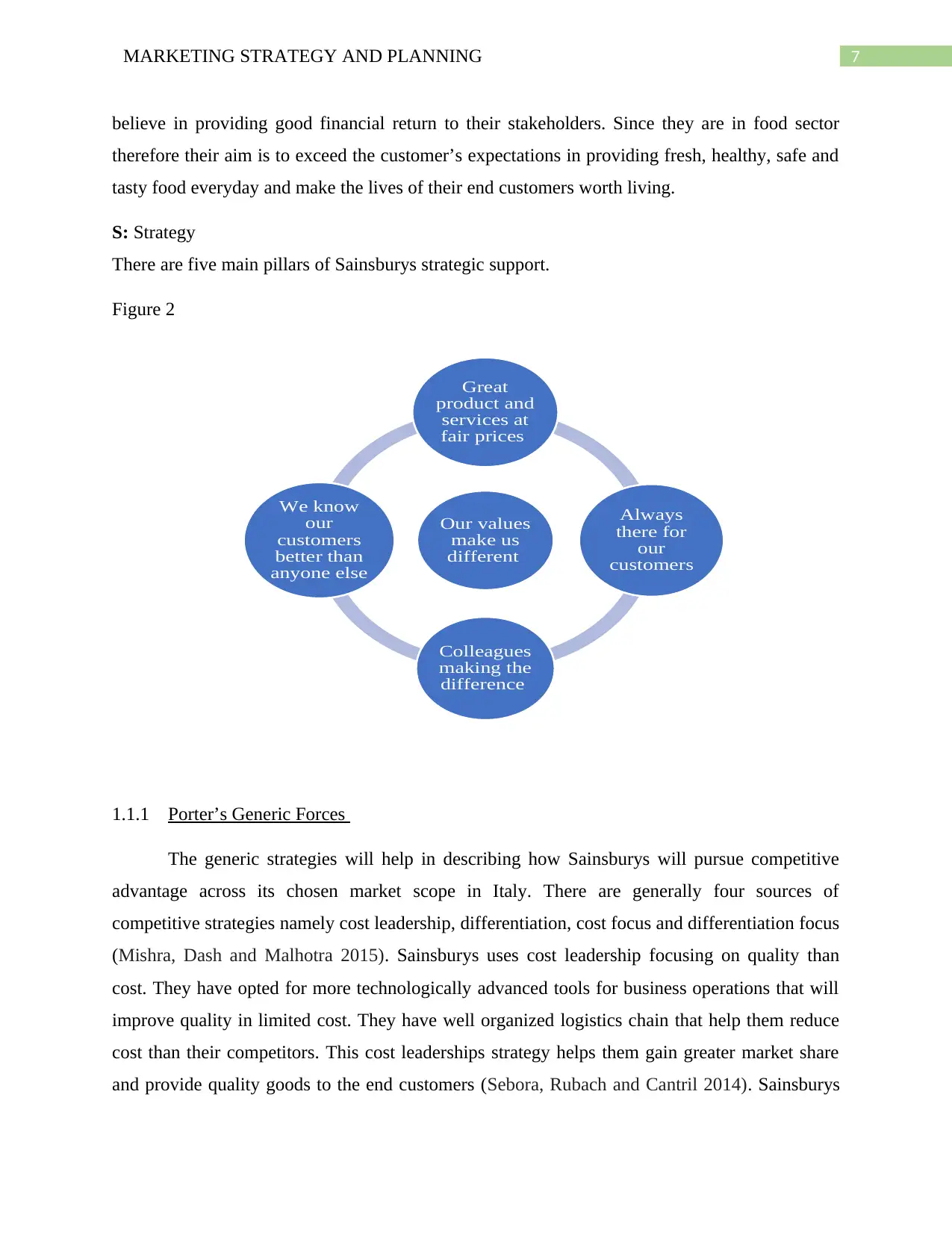
7MARKETING STRATEGY AND PLANNING
believe in providing good financial return to their stakeholders. Since they are in food sector
therefore their aim is to exceed the customer’s expectations in providing fresh, healthy, safe and
tasty food everyday and make the lives of their end customers worth living.
S: Strategy
There are five main pillars of Sainsburys strategic support.
Figure 2
1.1.1 Porter’s Generic Forces
The generic strategies will help in describing how Sainsburys will pursue competitive
advantage across its chosen market scope in Italy. There are generally four sources of
competitive strategies namely cost leadership, differentiation, cost focus and differentiation focus
(Mishra, Dash and Malhotra 2015). Sainsburys uses cost leadership focusing on quality than
cost. They have opted for more technologically advanced tools for business operations that will
improve quality in limited cost. They have well organized logistics chain that help them reduce
cost than their competitors. This cost leaderships strategy helps them gain greater market share
and provide quality goods to the end customers (Sebora, Rubach and Cantril 2014). Sainsburys
Our values
make us
different
Great
product and
services at
fair prices
Always
there for
our
customers
Colleagues
making the
difference
We know
our
customers
better than
anyone else
believe in providing good financial return to their stakeholders. Since they are in food sector
therefore their aim is to exceed the customer’s expectations in providing fresh, healthy, safe and
tasty food everyday and make the lives of their end customers worth living.
S: Strategy
There are five main pillars of Sainsburys strategic support.
Figure 2
1.1.1 Porter’s Generic Forces
The generic strategies will help in describing how Sainsburys will pursue competitive
advantage across its chosen market scope in Italy. There are generally four sources of
competitive strategies namely cost leadership, differentiation, cost focus and differentiation focus
(Mishra, Dash and Malhotra 2015). Sainsburys uses cost leadership focusing on quality than
cost. They have opted for more technologically advanced tools for business operations that will
improve quality in limited cost. They have well organized logistics chain that help them reduce
cost than their competitors. This cost leaderships strategy helps them gain greater market share
and provide quality goods to the end customers (Sebora, Rubach and Cantril 2014). Sainsburys
Our values
make us
different
Great
product and
services at
fair prices
Always
there for
our
customers
Colleagues
making the
difference
We know
our
customers
better than
anyone else
Paraphrase This Document
Need a fresh take? Get an instant paraphrase of this document with our AI Paraphraser
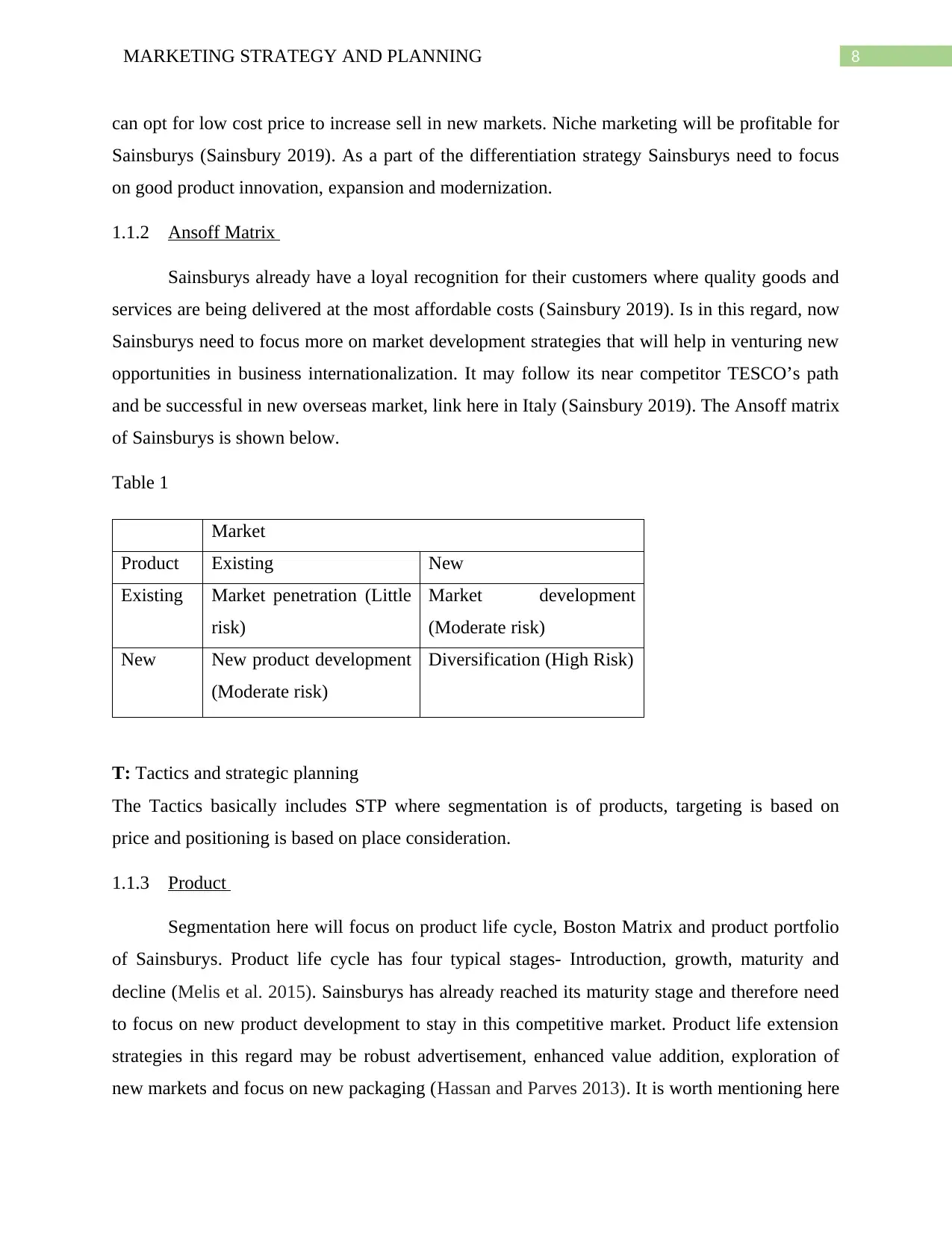
8MARKETING STRATEGY AND PLANNING
can opt for low cost price to increase sell in new markets. Niche marketing will be profitable for
Sainsburys (Sainsbury 2019). As a part of the differentiation strategy Sainsburys need to focus
on good product innovation, expansion and modernization.
1.1.2 Ansoff Matrix
Sainsburys already have a loyal recognition for their customers where quality goods and
services are being delivered at the most affordable costs (Sainsbury 2019). Is in this regard, now
Sainsburys need to focus more on market development strategies that will help in venturing new
opportunities in business internationalization. It may follow its near competitor TESCO’s path
and be successful in new overseas market, link here in Italy (Sainsbury 2019). The Ansoff matrix
of Sainsburys is shown below.
Table 1
Market
Product Existing New
Existing Market penetration (Little
risk)
Market development
(Moderate risk)
New New product development
(Moderate risk)
Diversification (High Risk)
T: Tactics and strategic planning
The Tactics basically includes STP where segmentation is of products, targeting is based on
price and positioning is based on place consideration.
1.1.3 Product
Segmentation here will focus on product life cycle, Boston Matrix and product portfolio
of Sainsburys. Product life cycle has four typical stages- Introduction, growth, maturity and
decline (Melis et al. 2015). Sainsburys has already reached its maturity stage and therefore need
to focus on new product development to stay in this competitive market. Product life extension
strategies in this regard may be robust advertisement, enhanced value addition, exploration of
new markets and focus on new packaging (Hassan and Parves 2013). It is worth mentioning here
can opt for low cost price to increase sell in new markets. Niche marketing will be profitable for
Sainsburys (Sainsbury 2019). As a part of the differentiation strategy Sainsburys need to focus
on good product innovation, expansion and modernization.
1.1.2 Ansoff Matrix
Sainsburys already have a loyal recognition for their customers where quality goods and
services are being delivered at the most affordable costs (Sainsbury 2019). Is in this regard, now
Sainsburys need to focus more on market development strategies that will help in venturing new
opportunities in business internationalization. It may follow its near competitor TESCO’s path
and be successful in new overseas market, link here in Italy (Sainsbury 2019). The Ansoff matrix
of Sainsburys is shown below.
Table 1
Market
Product Existing New
Existing Market penetration (Little
risk)
Market development
(Moderate risk)
New New product development
(Moderate risk)
Diversification (High Risk)
T: Tactics and strategic planning
The Tactics basically includes STP where segmentation is of products, targeting is based on
price and positioning is based on place consideration.
1.1.3 Product
Segmentation here will focus on product life cycle, Boston Matrix and product portfolio
of Sainsburys. Product life cycle has four typical stages- Introduction, growth, maturity and
decline (Melis et al. 2015). Sainsburys has already reached its maturity stage and therefore need
to focus on new product development to stay in this competitive market. Product life extension
strategies in this regard may be robust advertisement, enhanced value addition, exploration of
new markets and focus on new packaging (Hassan and Parves 2013). It is worth mentioning here
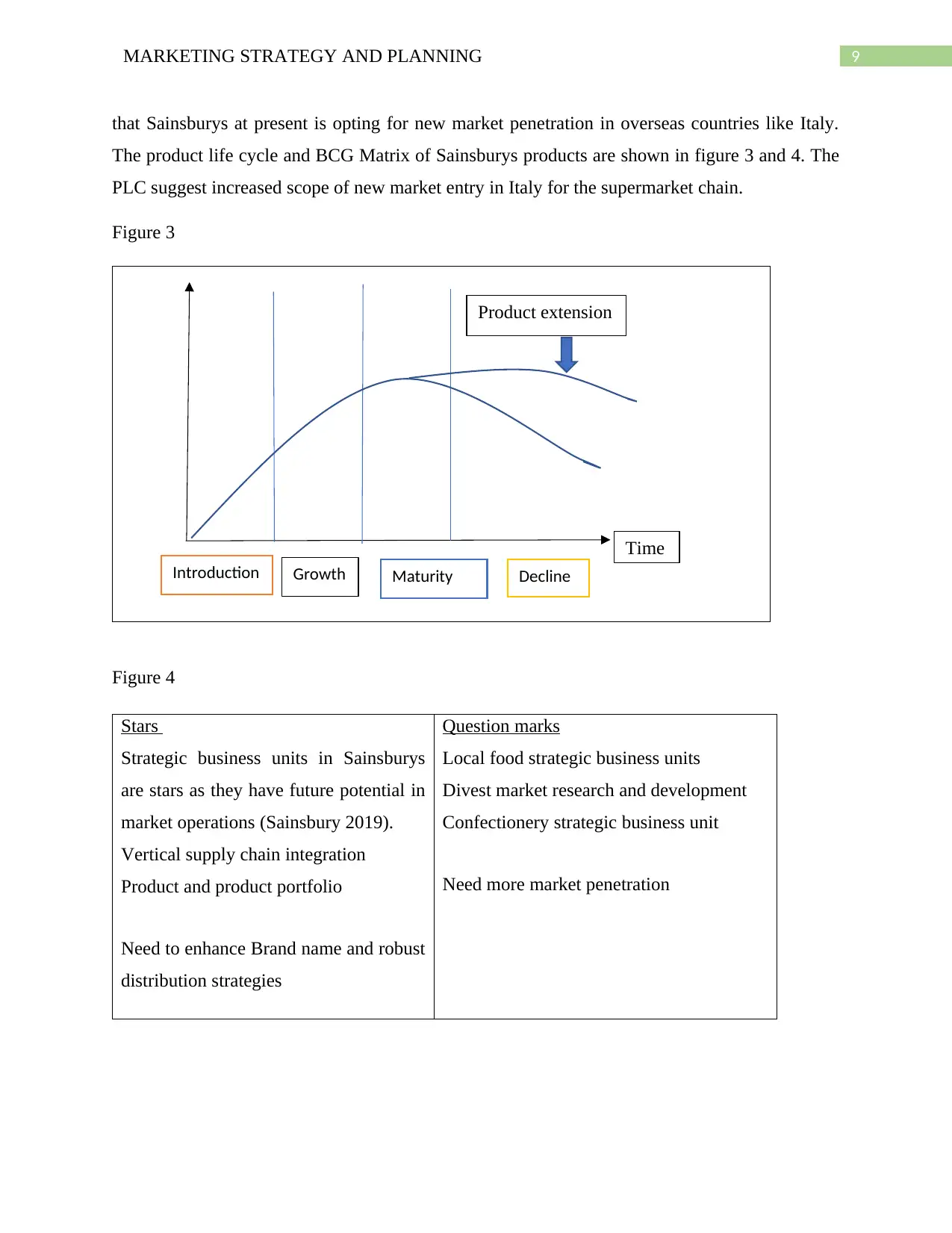
9MARKETING STRATEGY AND PLANNING
that Sainsburys at present is opting for new market penetration in overseas countries like Italy.
The product life cycle and BCG Matrix of Sainsburys products are shown in figure 3 and 4. The
PLC suggest increased scope of new market entry in Italy for the supermarket chain.
Figure 3
Figure 4
Stars
Strategic business units in Sainsburys
are stars as they have future potential in
market operations (Sainsbury 2019).
Vertical supply chain integration
Product and product portfolio
Need to enhance Brand name and robust
distribution strategies
Question marks
Local food strategic business units
Divest market research and development
Confectionery strategic business unit
Need more market penetration
Product extension
Introduction MaturityGrowth Decline
Time
that Sainsburys at present is opting for new market penetration in overseas countries like Italy.
The product life cycle and BCG Matrix of Sainsburys products are shown in figure 3 and 4. The
PLC suggest increased scope of new market entry in Italy for the supermarket chain.
Figure 3
Figure 4
Stars
Strategic business units in Sainsburys
are stars as they have future potential in
market operations (Sainsbury 2019).
Vertical supply chain integration
Product and product portfolio
Need to enhance Brand name and robust
distribution strategies
Question marks
Local food strategic business units
Divest market research and development
Confectionery strategic business unit
Need more market penetration
Product extension
Introduction MaturityGrowth Decline
Time
⊘ This is a preview!⊘
Do you want full access?
Subscribe today to unlock all pages.

Trusted by 1+ million students worldwide
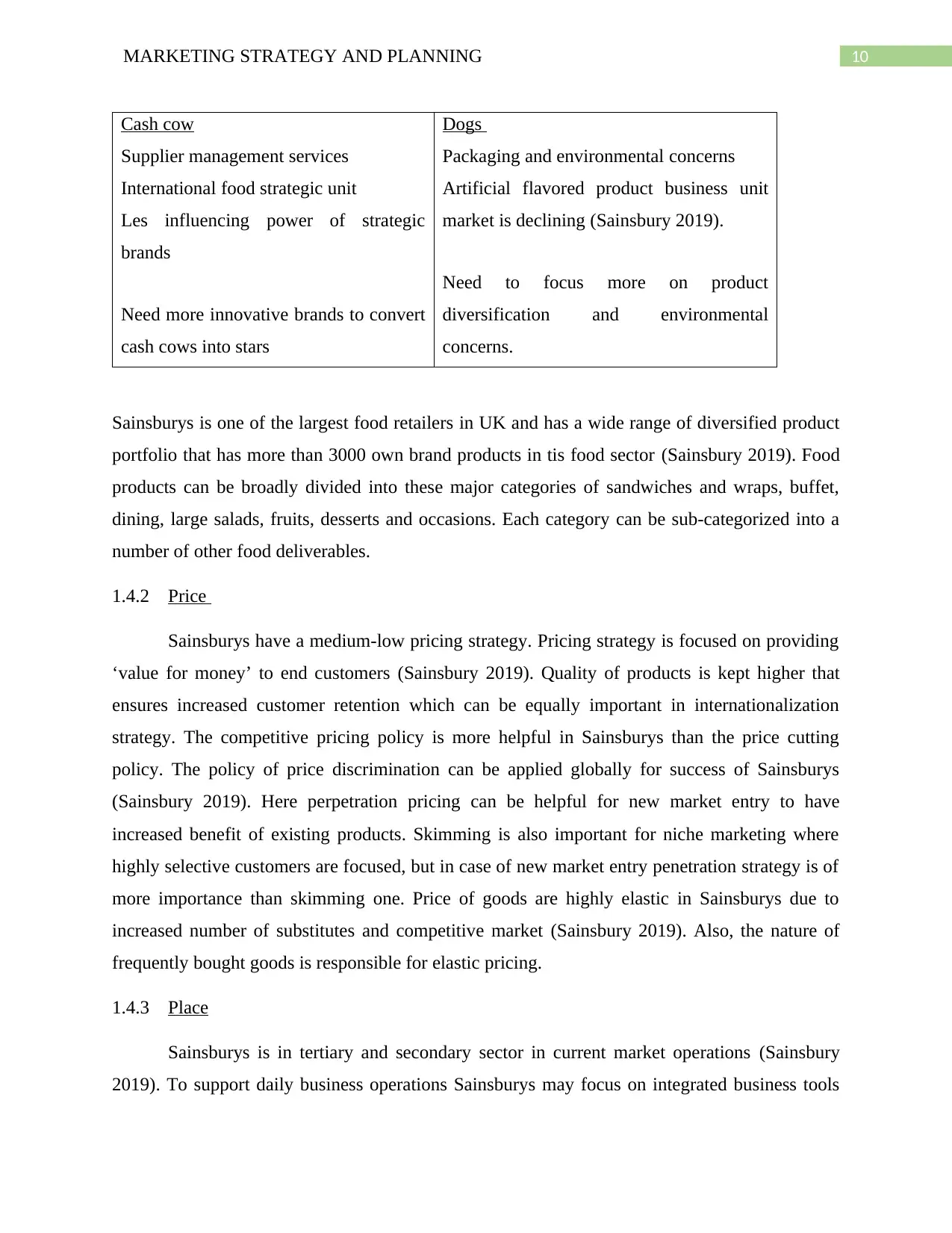
10MARKETING STRATEGY AND PLANNING
Cash cow
Supplier management services
International food strategic unit
Les influencing power of strategic
brands
Need more innovative brands to convert
cash cows into stars
Dogs
Packaging and environmental concerns
Artificial flavored product business unit
market is declining (Sainsbury 2019).
Need to focus more on product
diversification and environmental
concerns.
Sainsburys is one of the largest food retailers in UK and has a wide range of diversified product
portfolio that has more than 3000 own brand products in tis food sector (Sainsbury 2019). Food
products can be broadly divided into these major categories of sandwiches and wraps, buffet,
dining, large salads, fruits, desserts and occasions. Each category can be sub-categorized into a
number of other food deliverables.
1.4.2 Price
Sainsburys have a medium-low pricing strategy. Pricing strategy is focused on providing
‘value for money’ to end customers (Sainsbury 2019). Quality of products is kept higher that
ensures increased customer retention which can be equally important in internationalization
strategy. The competitive pricing policy is more helpful in Sainsburys than the price cutting
policy. The policy of price discrimination can be applied globally for success of Sainsburys
(Sainsbury 2019). Here perpetration pricing can be helpful for new market entry to have
increased benefit of existing products. Skimming is also important for niche marketing where
highly selective customers are focused, but in case of new market entry penetration strategy is of
more importance than skimming one. Price of goods are highly elastic in Sainsburys due to
increased number of substitutes and competitive market (Sainsbury 2019). Also, the nature of
frequently bought goods is responsible for elastic pricing.
1.4.3 Place
Sainsburys is in tertiary and secondary sector in current market operations (Sainsbury
2019). To support daily business operations Sainsburys may focus on integrated business tools
Cash cow
Supplier management services
International food strategic unit
Les influencing power of strategic
brands
Need more innovative brands to convert
cash cows into stars
Dogs
Packaging and environmental concerns
Artificial flavored product business unit
market is declining (Sainsbury 2019).
Need to focus more on product
diversification and environmental
concerns.
Sainsburys is one of the largest food retailers in UK and has a wide range of diversified product
portfolio that has more than 3000 own brand products in tis food sector (Sainsbury 2019). Food
products can be broadly divided into these major categories of sandwiches and wraps, buffet,
dining, large salads, fruits, desserts and occasions. Each category can be sub-categorized into a
number of other food deliverables.
1.4.2 Price
Sainsburys have a medium-low pricing strategy. Pricing strategy is focused on providing
‘value for money’ to end customers (Sainsbury 2019). Quality of products is kept higher that
ensures increased customer retention which can be equally important in internationalization
strategy. The competitive pricing policy is more helpful in Sainsburys than the price cutting
policy. The policy of price discrimination can be applied globally for success of Sainsburys
(Sainsbury 2019). Here perpetration pricing can be helpful for new market entry to have
increased benefit of existing products. Skimming is also important for niche marketing where
highly selective customers are focused, but in case of new market entry penetration strategy is of
more importance than skimming one. Price of goods are highly elastic in Sainsburys due to
increased number of substitutes and competitive market (Sainsbury 2019). Also, the nature of
frequently bought goods is responsible for elastic pricing.
1.4.3 Place
Sainsburys is in tertiary and secondary sector in current market operations (Sainsbury
2019). To support daily business operations Sainsburys may focus on integrated business tools
Paraphrase This Document
Need a fresh take? Get an instant paraphrase of this document with our AI Paraphraser
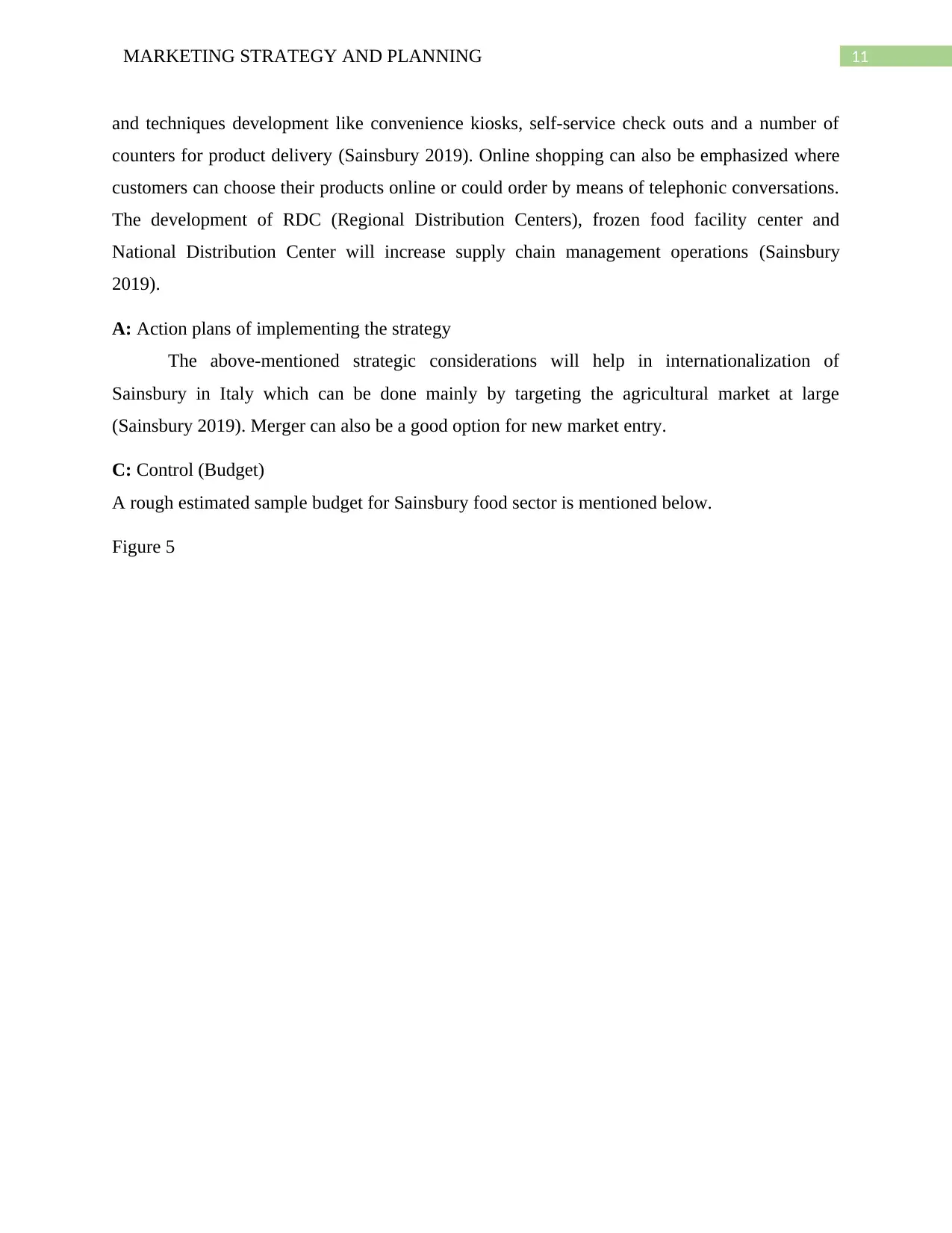
11MARKETING STRATEGY AND PLANNING
and techniques development like convenience kiosks, self-service check outs and a number of
counters for product delivery (Sainsbury 2019). Online shopping can also be emphasized where
customers can choose their products online or could order by means of telephonic conversations.
The development of RDC (Regional Distribution Centers), frozen food facility center and
National Distribution Center will increase supply chain management operations (Sainsbury
2019).
A: Action plans of implementing the strategy
The above-mentioned strategic considerations will help in internationalization of
Sainsbury in Italy which can be done mainly by targeting the agricultural market at large
(Sainsbury 2019). Merger can also be a good option for new market entry.
C: Control (Budget)
A rough estimated sample budget for Sainsbury food sector is mentioned below.
Figure 5
and techniques development like convenience kiosks, self-service check outs and a number of
counters for product delivery (Sainsbury 2019). Online shopping can also be emphasized where
customers can choose their products online or could order by means of telephonic conversations.
The development of RDC (Regional Distribution Centers), frozen food facility center and
National Distribution Center will increase supply chain management operations (Sainsbury
2019).
A: Action plans of implementing the strategy
The above-mentioned strategic considerations will help in internationalization of
Sainsbury in Italy which can be done mainly by targeting the agricultural market at large
(Sainsbury 2019). Merger can also be a good option for new market entry.
C: Control (Budget)
A rough estimated sample budget for Sainsbury food sector is mentioned below.
Figure 5
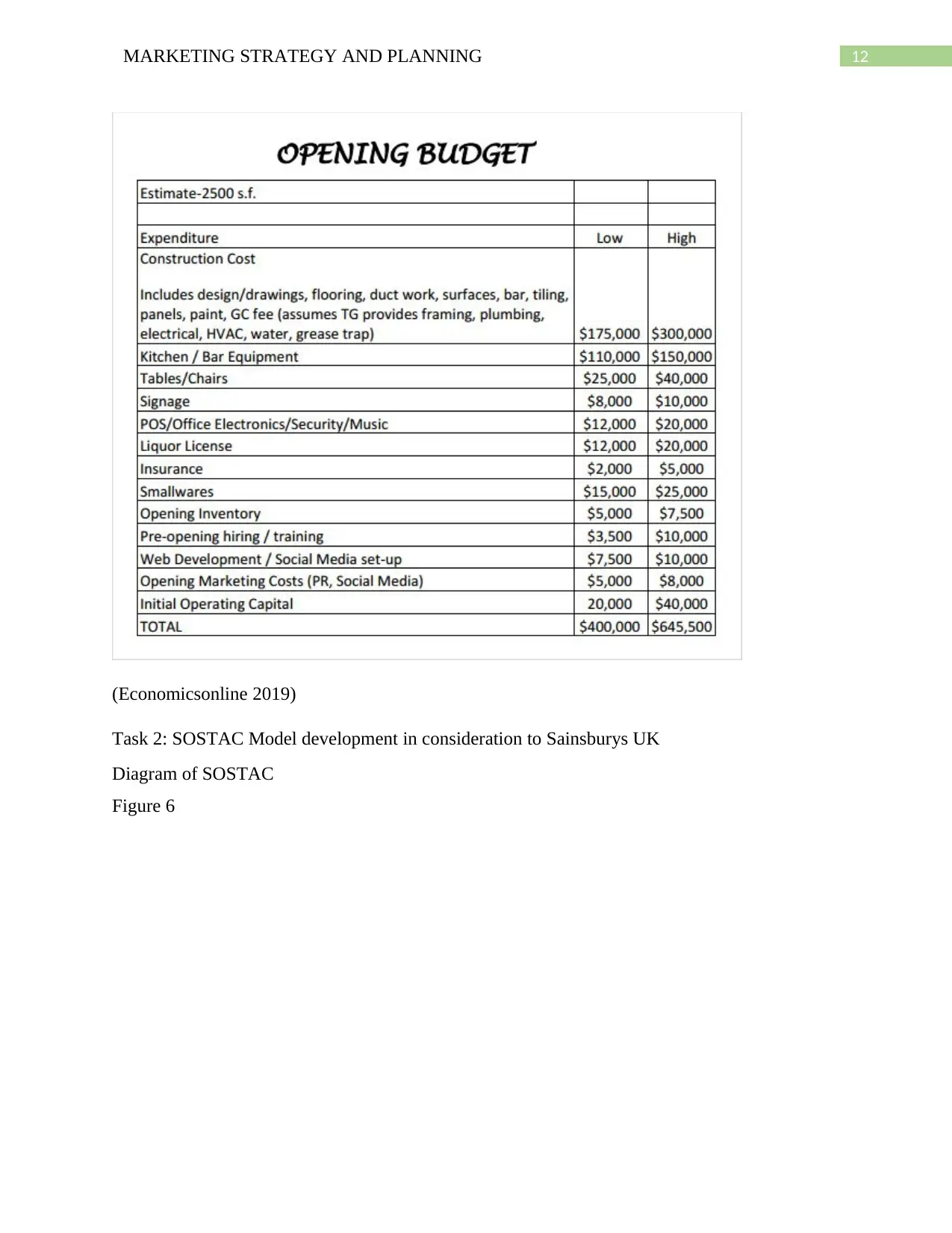
12MARKETING STRATEGY AND PLANNING
(Economicsonline 2019)
Task 2: SOSTAC Model development in consideration to Sainsburys UK
Diagram of SOSTAC
Figure 6
(Economicsonline 2019)
Task 2: SOSTAC Model development in consideration to Sainsburys UK
Diagram of SOSTAC
Figure 6
⊘ This is a preview!⊘
Do you want full access?
Subscribe today to unlock all pages.

Trusted by 1+ million students worldwide
1 out of 20
Related Documents
Your All-in-One AI-Powered Toolkit for Academic Success.
+13062052269
info@desklib.com
Available 24*7 on WhatsApp / Email
![[object Object]](/_next/static/media/star-bottom.7253800d.svg)
Unlock your academic potential
Copyright © 2020–2025 A2Z Services. All Rights Reserved. Developed and managed by ZUCOL.





